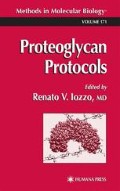Abstract
Amino acid sequence analysis of proteoglycans is performed using many of the same methods that are used for conventional proteins and glycoproteins, with some specific modifications that result from the glycosaminoglycans that are attached to the protein core. Amino acid sequence analysis of proteoglycans is more challenging than for conventional proteins for two reasons. First, because proteoglycans are large molecules, they have the same problems that are inherent in sequence analysis of larger proteins. The higher molecular weight provides for relatively high levels of nonspecific cleavage of the protein during Edman chemistry, resulting in a rapidly increasing background. Second, the presence of glycosaminoglycans, which tend to bind water, can exacerbate the problem of nonspecific hydrolysis of peptide bonds to such an extent that it may be impossible to obtain an N-terminal on a proteoglycan that is over 70% glycosaminoglycan. In an ideal situation, it is difficult to determine more than 10 amino acids from the N-terminal of an intact proteoglycan.
Access this chapter
Tax calculation will be finalised at checkout
Purchases are for personal use only
References
Edman, P. (1956) Mechanism of the phenylisothiocyanate degradation of proteins. Nature 177, 667–668.
Williams, K. R., Samander, S. M., Stone, K. L., Saylor, M., and Rush, J. (1996) Matrix-assisted laser desorption ionization mass spectrometry as a complement to internal protein sequencing, in The Protein Protocols Handbook (Walker, J. M., ed.), Humana Press, Totowa, NJ, pp. 541–555
Fernandez, J., and Mische, S. M. (1996) Enzymatic digestion of membrane-bound proteins for peptide mapping and internal sequence analysis, in The Protein Protocols Handbook (Walker, J. M., ed.), Humana Press, Totowa, NJ, pp. 405–414.
Stone, K. L. and Williams, K. R. (1996) Enzymatic digestion of proteins in solution and in SDS-polyacrylamide gels, in The Protein Protocols Handbook (Walker, J. M., ed), Humana Press, Totowa, NJ,, pp. 415–425.
Stone, K. L. and Williams, K. R. (1996) Reverse-phase HPLC separation of enzymatic digests of proteins, in The Protein Protocols Handbook (Walker, J. M., ed.), Humana Press, Totowa, NJ, pp. 427–434.
Barry, F. P., Rosenberg, L. C., Gaw, J. U., Gaw, J. U., Koob, T. J., and Neame, P. J. (1995) N-and O-linked keratan sulfate on the hyaluronan binding region of aggrecan from mature and immature bovine cartilage. J. Biol. Chem. 270, 20516–20524.
Fisher, L. W., Hawkins, G. R., Tuross, N., and Termine, J. D. (1987) Purification and partial characterization of small proteoglycans I and II, bone sialoproteins I and II, and osteonectin from the mineral compartment of developing human bone. J. Biol. Chem. 262, 9702–9708.
Sandy, J. D., Neame, P. J., Boynton, R. E., and Flannery, C. R. (1991) Catabolism of aggrecan in cartilage explants. Identification of a major cleavage within the interglobular domain. J. Biol. Chem. 266, 8683–8685.
Farndale, R. W., Buttle, D. J., and Barrett, A. J. (1986) Improved quantitation and discrimination of sulphated glycosaminoglycans by use of dimethylmethylene blue. Biochim. Biophys. Acta. 883, 173–177.
Johnson, H. J., Rosenberg, L., Choi, H., Garza, S., Höök, M., and Neame, P. J. (1997) Characterization of epiphycan, a small proteoglycan with a leucine-rich core protein. J. Biol. Chem. 272, 18709–18717.
Fernandez, J., DeMott, M., Atherton, D., and Mische, S. M. (1992) Internal protein sequence analysis: enzymatic digestion for less than 10 μg of protein bound to polyvinyldifluoride or nitrocellulose membranes. Anal. Biochem. 201, 255–264.
Author information
Authors and Affiliations
Editor information
Editors and Affiliations
Rights and permissions
Copyright information
© 2001 Humana Press Inc., Totowa, NJ
About this protocol
Cite this protocol
Neame, P.J. (2001). Preparation of Proteoglycans for N-Terminal and Internal Amino Acid Sequence Analysis. In: Iozzo, R.V. (eds) Proteoglycan Protocols. Methods in Molecular Biology™, vol 171. Humana Press. https://doi.org/10.1385/1-59259-209-0:067
Download citation
DOI: https://doi.org/10.1385/1-59259-209-0:067
Publisher Name: Humana Press
Print ISBN: 978-0-89603-759-5
Online ISBN: 978-1-59259-209-8
eBook Packages: Springer Protocols

